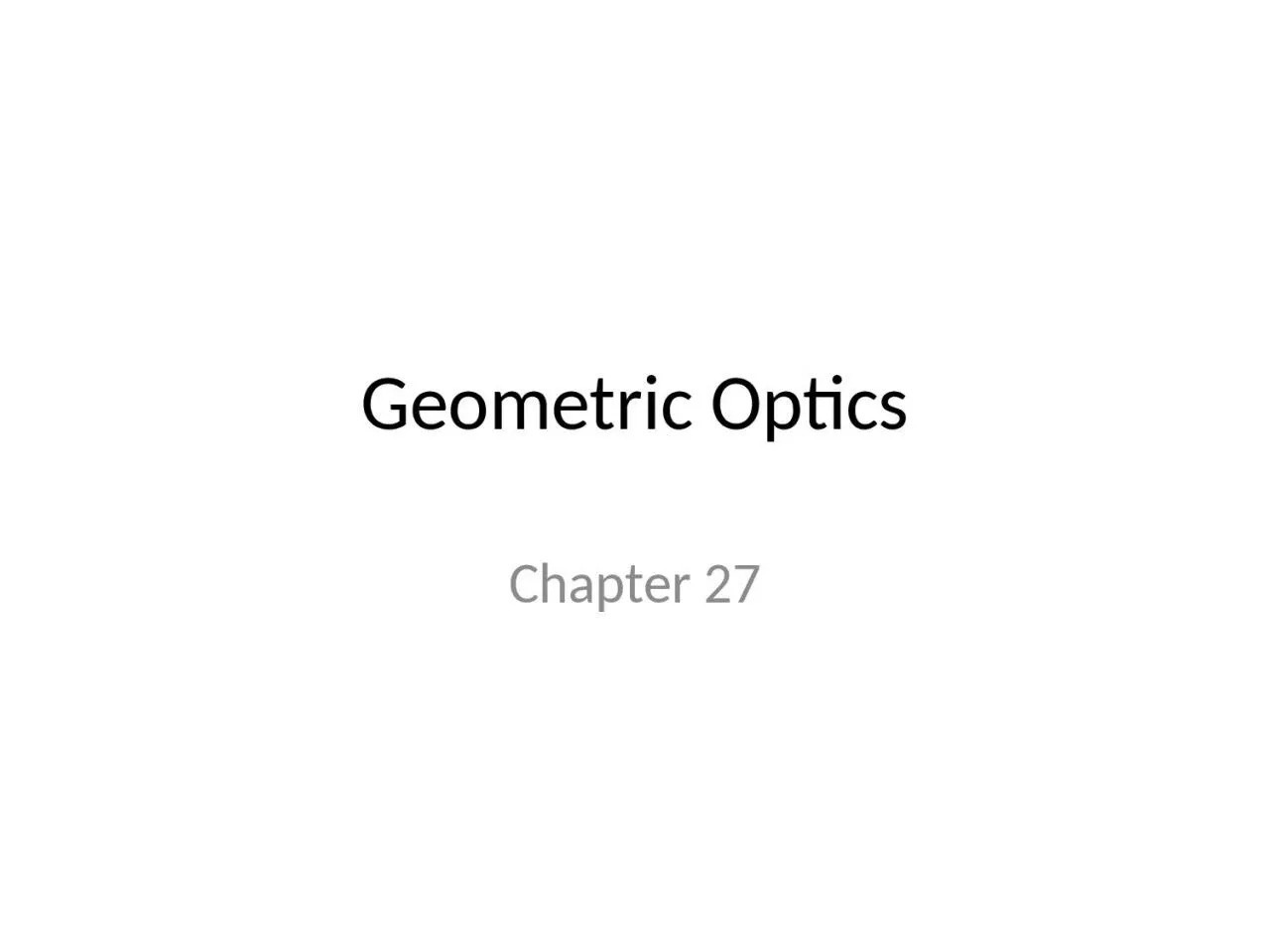

237 Thin Lenses Ray Tracing Parallel rays are brought to a focus by a converging lens one that is thicker in the center than it is at the edge Double convex lens 237 Thin Lenses Ray Tracing ID: 1031636
Download Presentation The PPT/PDF document "Geometric Optics Chapter 27" is the property of its rightful owner. Permission is granted to download and print the materials on this web site for personal, non-commercial use only, and to display it on your personal computer provided you do not modify the materials and that you retain all copyright notices contained in the materials. By downloading content from our website, you accept the terms of this agreement.
1. Geometric OpticsChapter 27
2. 23.7 Thin Lenses; Ray TracingParallel rays are brought to a focus by a converging lens (one that is thicker in the center than it is at the edge).Double convex lens
3. 23.7 Thin Lenses; Ray TracingA diverging lens (thicker at the edge than in the center) make parallel light diverge; the focal point is that point where the diverging rays would converge if projected back.
4. 23.7 Thin Lenses; Ray TracingThe power of a lens is the inverse of its focal length.(23-7)Lens power is measured in diopters, D. 1 D = 1 m-1
5. 23.7 Thin Lenses; Ray TracingRay tracing for thin lenses is similar to that for mirrors. We have three key rays: This ray comes in parallel to the axis and exits through the focal point. This ray comes in through the focal point and exits parallel to the axis. This ray goes through the center of the lens and is undeflected.
6. 23.7 Thin Lenses; Ray Tracing
7. 23.7 Thin Lenses; Ray TracingFor a diverging lens, we can use the same three rays; the image is upright and virtual.
8.
9.
10.
11.
12. 23.8 The Thin Lens Equation; MagnificationThe thin lens equation is the same as the mirror equation:(23-8)
13. 23.8 The Thin Lens Equation; MagnificationThe sign conventions are slightly different: The focal length is positive for converging lenses and negative for diverging. The object distance is positive when the object is on the same side as the light entering the lens (not an issue except in compound systems); otherwise it is negative. The image distance is positive if the image is on the opposite side from the light entering the lens; otherwise it is negative. The height of the image is positive if the image is upright and negative otherwise.
14. 23.8 The Thin Lens Equation; MagnificationThe magnification formula is also the same as that for a mirror:(23-9)The power of a lens is positive if it is converging and negative if it is diverging.
15. 23.8 The Thin Lens Equation; MagnificationProblem Solving: Thin Lenses Draw a ray diagram. The image is located where the key rays intersect. Solve for unknowns. Follow the sign conventions. Check that your answers are consistent with the ray diagram.
16. Example Problem #1A 4.00-cm tall light bulb is placed a distance of 45.7 cm from a double convex lens having a focal length of 15.2 cm. Determine the image distance and the image size.
17. Given:Find:Solution:ho = 4.00 cmdo = 45.7 cmf = 15.2 cmdi = ???hi = ???di = 22.8 cm1/f = 1/do + 1/di 1/(15.2 cm) = 1/(45.7 cm) + 1/di0.0658 cm-1 = 0.0219 cm-1 + 1/di0.0439 cm-1 = 1/di
18. hi = -1.99 cmhi/ho = - di/do hi /(4.00 cm) = - (22.8 cm)/(45.7 cm)hi = - (4.00 cm) • (22.8 cm)/(45.7 cm)The negative values for image height indicate that the image is an inverted image.
19. From the calculations in this problem it can be concluded that if a 4.00-cm tall object is placed 45.7 cm from a double convex lens having a focal length of 15.2 cm, then the image will be inverted, 1.99-cm tall and located 22.8 cm from the lens.
20. Practice Problem:A 4.00-cm tall light bulb is placed a distance of 8.30 cm from a double convex lens having a focal length of 15.2 cm. (NOTE: this is the same object and the same lens, only this time the object is placed closer to the lens.) Determine the image distance and the image size.
21. Given:Find:Solution:ho = 4.00 cmdo = 8.3 cmf = 15.2 cmdi = ???hi = ???di = -18.3 cm1/f = 1/do + 1/di 1/(15.2 cm) = 1/(8.30 cm) + 1/di0.0658 cm-1 = 0.120 cm-1 + 1/di-0.0547 cm-1 = 1/diThe negative value for image distance indicates that the image is a virtual image located on the object's side of the lens.
22. hi = 8.81 cmhi/ho = - di/do hi /(4.00 cm) = - (-18.3 cm)/(8.30 cm)hi = - (4.00 cm) • (-18.3 cm)/(8.30 cm)Note also that the image height is a positive value, meaning an upright image. Any image that is upright and located on the object's side of the lens is considered to be a virtual image.
23. From the calculations in the second sample problem it can be concluded that if a 4.00-cm tall object is placed 8.30 cm from a double convex lens having a focal length of 15.2 cm, then the image will be enlarged, upright, 8.81-cm tall and located 18.3 cm from the lens on the object's side.